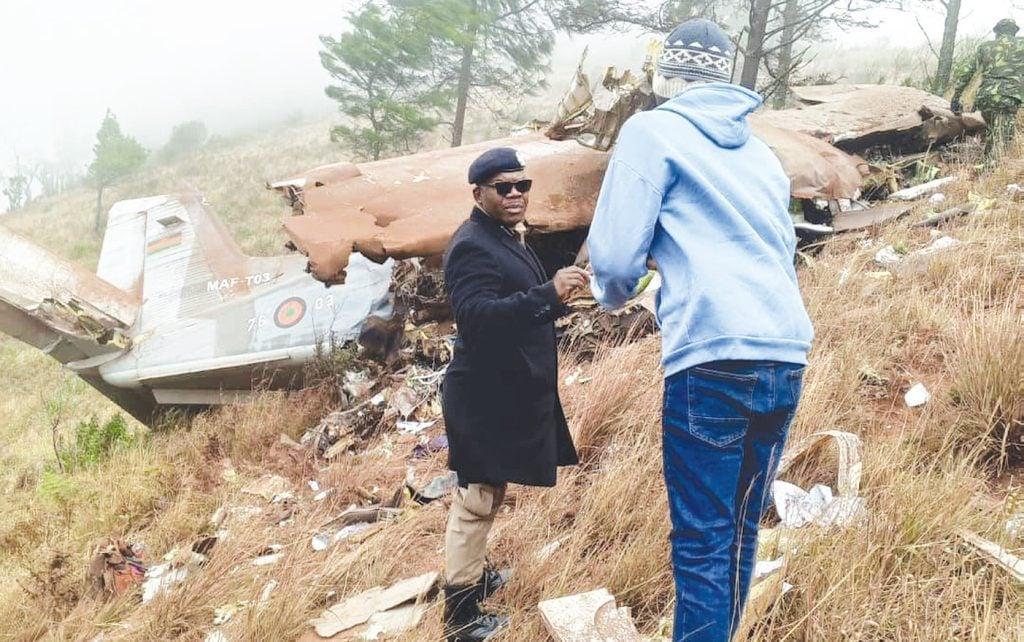Africa-Press – Malawi. On the morning of June 10, 2024, a quiet fog rolled over the hills of northern Malawi. Deep in the forested rise of Nthungwa, a sharp explosion shattered the stillness. Moments earlier, a Dornier 228 aircraft operated by the Malawi Air Force had slammed into the side of a steep hill, disintegrating on impact.
All nine people on board – three crew members and six passengers, including Malawi’s Vice President, Dr Saulos Klaus Chilima – were killed instantly.
What was meant to be a simple 50-minute domestic flight from the capital, Lilongwe, to the northern city of Mzuzu turned fatal due to a deadly mix of human error, poor decision-making, and institutional failure.
A detailed investigation report released on May 8, 2025, by Germany’s Federal Bureau of Aircraft Accident Investigation (BFU), offers a sobering and thorough account of the events leading up to the crash.
The inquiry was launched at the official request of the Malawian government, which lacked the capacity to conduct such an investigation. Under ICAO Annex 13 procedures, Malawi handed full responsibility to Germany.
The BFU team, supported by an expert from the aircraft’s manufacturer (General Atomics AeroTec Systems), worked closely with Malawian officials for nearly 11 months.
The final report, numbered BFU24-0508-DX, is the only official investigation released on the crash. It spans over 55 pages of analysis and flight data and weather assessments and includes six formal safety recommendations.
The report outlines a grim but factual timeline, highlighting both immediate and systemic causes, chief among them poor flight planning, lack of proper weather briefing, risky in-flight decisions, and a wider culture of unsafe military aviation practices in Malawi.
The flight began early. The same Dornier 228 had already flown that morning to pick up the vice president and his team from Lilongwe.
Before the return flight to Mzuzu, the co-pilot filed a flight plan that avoided the standard route, citing poor weather earlier in the day. But crucially, the crew did not get an official meteorological briefing from the weather office.
Instead, they made a phone call to Mzuzu’s Flight Information Service, a clear breach of aviation regulations. At that time, weather conditions at Mzuzu seemed acceptable. But hours later, they had changed.
The aircraft took off shortly after 9:00 a.m. and climbed steadily. Radio contact with air traffic control was established early on, but radar contact was lost as the plane flew at a low altitude below radar coverage.
As the aircraft neared Mzuzu, weather conditions deteriorated quickly. Visibility dropped below 8 kilometres. Low clouds and light rain covered the airport.
Despite this, the crew continued. GPS data recovered from the aircraft’s Garmin system revealed erratic flight paths. The pilots began making full turns at dangerously low altitudes, some as low as 185 feet above the ground.
The aircraft weaved between hills and valleys, trying to find a visual path to the runway. This dangerous practice is known as “scud running”, flying below clouds in marginal weather to avoid using instrument flight rules.
The final minutes were frantic. The plane made sharp turns and sudden altitude changes, as if searching for a safe corridor through the terrain. Witnesses near the crash site later described thick fog, strong winds, and almost no visibility.
At 10:16 a.m., flying blind and disoriented, the aircraft struck a hillside just 500 metres from a telecommunications tower. It broke apart on impact. There were no survivors.
The BFU report ruled out mechanical failure. The aircraft was airworthy.
Instead, the crash was blamed on poor flight planning, ignoring worsening weather, and broader failures in Malawi’s aviation oversight.
Though experienced on the aircraft type, the captain had not undergone a documented medical exam in years.
The Dornier 228 had a working navigation display and terrain awareness feature, but it remains unclear if these were in use during the flight.
Even more alarming: the plane’s Emergency Locator Transmitter had not worked in over 20 years. Its battery expired in 2004. As a result, no emergency signal was sent after the crash.
It took more than 24 hours and assistance from foreign drones and helicopters for rescuers to find the wreckage. This was not just a weather-related accident. It was a failure of the entire system:
Navigation aids at Mzuzu had been decommissioned over 15 years ago, yet still appeared on official charts.
No radar or voice recording existed for low-altitude airspace.
A military flying culture where “scud running” had become normal in poor visibility conditions.
The vice president’s death plunged Malawi into national mourning. A respected reformer and possible future president, Dr Chilima’s loss deeply affected both the nation and its fragile political future.
In response, the BFU issued six safety recommendations to Malawi’s Ministry of Defence, Ministry of Transport, the Civil Aviation Authority, and the Air Force.
These include calls for better pilot training, modernised navigation and safety equipment, and stricter weather briefing protocols.
For More News And Analysis About Malawi Follow Africa-Press






